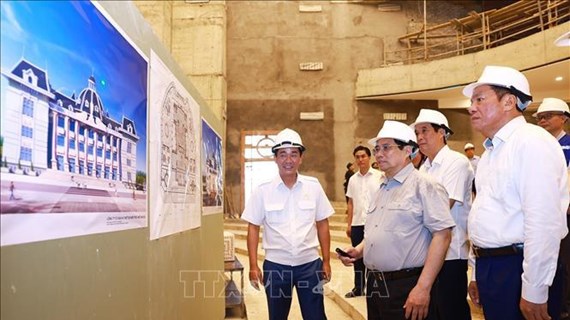Over the past four years, Vietnamese and Japanese experts have partnered
with each other to preserve the UNESCO-recognised Thang Long-Hanoi
Citadel while promoting its image to the world under a project financed
by the Japanese Fund-in-Trust.
The 1.1 million USD project aims to build a suitable management system for the citadel serving long-term preservation, contributing to the community’s sustainable development, said Nguyen Van Son, Director of the Thang Long-Hanoi Heritage Conservation Centre, said at a seminar in Hanoi on December 18 to review the four-year project.
In 2010, with the support of Japanese partners, the Vietnam Institute of Vietnamese Studies and Development Sciences discovered new facts about the citadel.
Based on its name and architecture, scientists have proven the similarity in planning shared by the Thang Long Citadel and other citadels in Southeast and Northeast Asian countries.
The project has also helped young Vietnamese archaeologists access advanced methods while promoting the development of Vietnam ’s urban archaeology.
Thanks to Japan ’s machinery and equipment assistance and consultations, a geographic information system has been established to support the management of the heritage.
The project has also published various books and made souvenirs highlighting special values of the citadel.
The Thang Long Citadel was recognised by the United Nations Educational, Scientific and Cultural Organisation (UNESCO) as part of the world cultural heritage in 2010.
The site won the recognition thanks to its three outstanding characteristics: the length of its cultural history, the continuity of the citadel as a power centre and the variety of relics it contains.
Also on December 18, the Hanoi People’s Committee presented certificates of merit to the UNESCO Office in Vietnam and the Tokyo Research Institute of Cultural Properties for their contributions to protecting the heritage.-VNA
The 1.1 million USD project aims to build a suitable management system for the citadel serving long-term preservation, contributing to the community’s sustainable development, said Nguyen Van Son, Director of the Thang Long-Hanoi Heritage Conservation Centre, said at a seminar in Hanoi on December 18 to review the four-year project.
In 2010, with the support of Japanese partners, the Vietnam Institute of Vietnamese Studies and Development Sciences discovered new facts about the citadel.
Based on its name and architecture, scientists have proven the similarity in planning shared by the Thang Long Citadel and other citadels in Southeast and Northeast Asian countries.
The project has also helped young Vietnamese archaeologists access advanced methods while promoting the development of Vietnam ’s urban archaeology.
Thanks to Japan ’s machinery and equipment assistance and consultations, a geographic information system has been established to support the management of the heritage.
The project has also published various books and made souvenirs highlighting special values of the citadel.
The Thang Long Citadel was recognised by the United Nations Educational, Scientific and Cultural Organisation (UNESCO) as part of the world cultural heritage in 2010.
The site won the recognition thanks to its three outstanding characteristics: the length of its cultural history, the continuity of the citadel as a power centre and the variety of relics it contains.
Also on December 18, the Hanoi People’s Committee presented certificates of merit to the UNESCO Office in Vietnam and the Tokyo Research Institute of Cultural Properties for their contributions to protecting the heritage.-VNA













